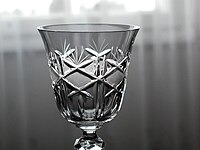
Photo from wikipedia
Summary A thermo-mechanical stress develops on the sealant of an solid oxide fuel cell (SOFC) stack because of thermal expansion coefficient (TEC) differences among ceramic electrolyte, metallic interconnector, and glass-ceramic… Click to show full abstract
Summary A thermo-mechanical stress develops on the sealant of an solid oxide fuel cell (SOFC) stack because of thermal expansion coefficient (TEC) differences among ceramic electrolyte, metallic interconnector, and glass-ceramic sealant. The stress initiates cracks and usually results in a sealing failure. This study offers a thermo-mechanically stable two-layered sealant to decrease thermo-mechanical stresses among the SOFC components. The novel sealant involves two layers in which TEC of the first layer is close to that of the interconnector, while TEC of the second layer is similar to that of the electrolyte. SiO2, CaO, Al2O3, and Na2O glass-ceramics are selected as a sealant material, and five cases are prepared by changing the amount of Al2O3 to obtain the appropriate properties close to both the interconnector and the electrolyte, separately. Tensile strength, wetting angles, shrinkages, and electrical resistances are measured to determine the sealant properties. To see effect of the reaction on the microstructure, scanning electron microscopy (SEM) tests are conducted for the samples exposed both in air and in crofer 22 APU. Long-term sealing performance of the novel sealant is compared with the traditional designs. While the two-layered sealant keeps 35 kPa pressure for 500 h after 100 thermal cycles, test pressure with traditional design reduces to 31–32 kPa after 50 h. Copyright © 2016 John Wiley & Sons, Ltd.
Journal Title: International Journal of Energy Research
Year Published: 2017
Link to full text (if available)
Share on Social Media: Sign Up to like & get
recommendations!